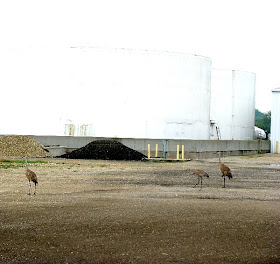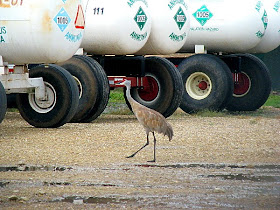
Thursday, August 26, 2010
Wednesday, August 25, 2010
Finally, the Red-tail in the Backyard

First there was one Thirteen-lined Ground Squirrel; then I saw one about a third the size of the original--a baby! Before I knew it every time I stepped out the back door it seemed that at least a dozen of them raced for their holes. And it wasn't just my yard, the neighbor was vainly setting live traps for them with very little success.
That's when I realized that likely with all this bounty, sooner or later, a Red-tailed Hawk would make an appearance, and today was the day.
Today, doing a nearly unconscious scan as I do whenever walking through the dining room, I got a jolt into consciousness. Hey! There's a Red-tailed Hawk circling in my back yard! Red tail gleaming in the sunlight.By the time I ran to the living room for the camera and opened the door--nothing. Wait something is hot winging it to the north obscuring itself with the tree branches. I can't tell if it's the same bird or not. Click, click, click. Is it a Red-tail? If so is it the same or different?

Looking at the photographs the answer to the first question is yes. See the dark patagial bar on the fore-edge of the wing? Is this bird mature or not?

I can't tell. See him just skimming the left most branch of the maple?
He likely skimmed the tree line and then slipped unnoticed into one of the evergreens a few houses over. No squirrels gave him away. This bird does stealth well. I often have at least ten squirrels knoshing at the feeder so the neighborhood has more than it's share but this guy got past all of them And Wisconsin is nearly bereft of Blue Jays due to West Nile so not help there either.
I did discover something from scrutinizing the photo though. Look in the top right corner.
Good thing Wisconsin Red-tails tend to be rodent eaters (or perhaps Doorstep and Friend do pretty good stealth too) or this hawk may have just crashed through the branches as Pale Male has been known to do with pigeons and made a grab for one of them.
But all was well and I've no doubt that eventually the visitor had ground squirrel for dinner-a much more substantial meal than a vole.
Donegal Browne
Monday, August 23, 2010
Blakeman on Friday's Juvenile Red-tail and the Cranes of Landmark Corn

Long time contributor, Red-tail expert John Blakeman, had some very perceptive insights concerning the passager (Thanks John for the new word!) featured in the previous post.
Donna,
You nailed the wire-perched red-tail exactly. The bird has seen voles in the ditch below before, and is hunting there again. I see summer inmatures doing this often, especially after July, when they have to hunt for themselves.
One photo shows the bird with its head slightly erect, and leaning over just a bit. This is the stature of a hungry, hunting passager (first year bird, near migration).
Every falconer would recognize (as you did, too) that hunting posture. The head is slightly elevated, not hunched down into the shoulder.

Then, there's the photo of the bird looking right at it's feet. Not so. It's discovered something vole-like right below, either a glimpse of a vole scooting along down there, or perhaps just a vacant vole runway. No matter what, the hawk saw something of profound interest, related to capturing some animal, almost surely a vole or a mouse at this roadside site.
And you are so correct in describing the bird's patience and time calculations regarding a stoop. By late summer, the bird has learned that it can't just jump off and chase everything it sees. That's what eyasses do in June and July. By now, they've learned that's a waste of time and energy, yielding few prey. Now, the bird, as shown here, does deliberate and calculated perch-hunting.
And it also learned that nothing was available here, so after a while it moved on down to the big pole. None of this is random. It's all a part of deliberate hunting routines the bird is using each day.
Sincerely,
John A. Blakeman

Sandhill Crane photos by Paul Anderson
Local mechanical engineer Paul Anderson looked through the back gate and who should he see trekking across the lot, but a family of Sandhill Cranes. Security fences being completely irrelevant,

and undaunted by a human environment...

in a typical Sandhill configuration, Mom leading the expedition, then Junior, with Dad as the rear guard...

the family of Sandhills strode with purpose past the tanks of hazardous Anhydrous Ammonia,

making a beeline for the companies stockpile of corn.
Donegal Browne







